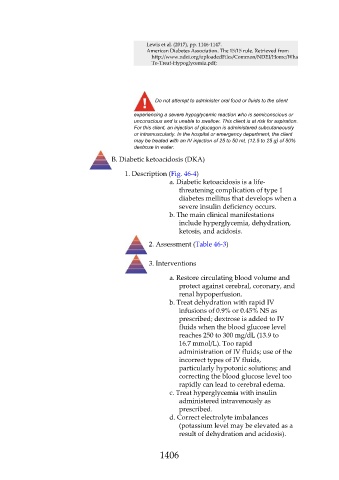Page 1406 - Saunders Comprehensive Review For NCLEX-RN
P. 1406
Lewis et al. (2017), pp. 1146-1147.
American Diabetes Association. The 15/15 rule. Retrieved from
http://www.ndei.org/uploadedFiles/Common/NDEI/Home/Whats_New/How-
To-Treat-Hypoglycemia.pdf;
Do not attempt to administer oral food or fluids to the client
experiencing a severe hypoglycemic reaction who is semiconscious or
unconscious and is unable to swallow. This client is at risk for aspiration.
For this client, an injection of glucagon is administered subcutaneously
or intramuscularly. In the hospital or emergency department, the client
may be treated with an IV injection of 25 to 50 mL (12.5 to 25 g) of 50%
dextrose in water.
B. Diabetic ketoacidosis (DKA)
1. Description (Fig. 46-4)
a. Diabetic ketoacidosis is a life-
threatening complication of type 1
diabetes mellitus that develops when a
severe insulin deficiency occurs.
b. The main clinical manifestations
include hyperglycemia, dehydration,
ketosis, and acidosis.
2. Assessment (Table 46-3)
3. Interventions
a. Restore circulating blood volume and
protect against cerebral, coronary, and
renal hypoperfusion.
b. Treat dehydration with rapid IV
infusions of 0.9% or 0.45% NS as
prescribed; dextrose is added to IV
fluids when the blood glucose level
reaches 250 to 300 mg/dL (13.9 to
16.7 mmol/L). Too rapid
administration of IV fluids; use of the
incorrect types of IV fluids,
particularly hypotonic solutions; and
correcting the blood glucose level too
rapidly can lead to cerebral edema.
c. Treat hyperglycemia with insulin
administered intravenously as
prescribed.
d. Correct electrolyte imbalances
(potassium level may be elevated as a
result of dehydration and acidosis).
1406

